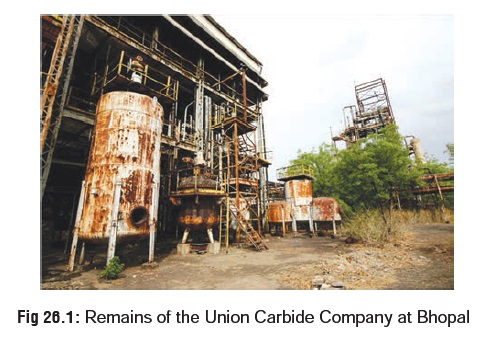Chapter: Modern Medical Toxicology: Asphyxiant Poisons: Toxic Gases
Methyl Isocyanate (MIC) - Respiratory Irritants Asphyxiant Poison
Methyl Isocyanate (MIC)
·
Methyl isocyanate (MIC) is one of a
group of isocyanates, the others being toluene di-isocyanate (TDI) and
diphenylmethane di-isocyanate (MDI).
Physical Appearance
·
Colourless liquid with a sharp odour, which becomes gaseous
at 390C. It is an extremely reactive chemical and needs to be stored carefully.
Contact with water results in an exothermic reaction.
·
Methyl isocyanate is produced by heating metal cyanates or
by heating N,N-diphenyl-N’-methylurea.
Uses
·
Manufacture of carbaryl (a carbamate
pesticide).
·
Manufacture of polyurethane articles
(plastics, urethane foam, adhesives, etc.).
Mode of Action
·
Methyl isocyanate (MIC) is a
powerful respiratory irritant. Even brief exposure at high concentrations may
cause severe injury, burns, or death.
Usual Fatal Dose
·
At 2 ppm, no odour is generally
discernible, but irritation and lacrimation may be noted. Symptoms become more
marked at 4 ppm and unbearable at 21 ppm.
·
Exposures to breathing zone
concentrations of 0.5 ppm are likely to produce a respiratory response.
Clinical Features
·
Inhalation of MIC gas produces immediate lacrimation,
photophobia, lid swelling, and corneal ulceration; cough, choking sensation,
dyspnoea, chest pain, haemoptysis, pink frothy discharge from nose, and
pulmonary oedema; less commonly vomiting, convulsions, and coma. Metabolic
acidosis has been reported.
·
Dermal exposure results in erythema and vesiculation.
·
Ocular exposure can cause permanent damage. A 40% increased
incidence of trachoma, 36% increased risk of other lid infection and 45%
increased incidence of irritant symp- toms were noted in the exposed population
of Bhopal resulting in a “Bhopal eye syndrome”. A follow-up study three years
after the Bhopal methyl isocyanate exposure demonstrated an excess of eyelid
infection, decreased visual acuity, cataracts, and eye irritation among
survivors as compared to controls.
·
There is conflicting data as to whether methyl isocyanate is
foetotoxic; however, it crosses the placental barrier. Reports from Bhopal, and
animal studies suggest a high degree of adverse reproductive effects and
teratogenicity. Long-term effects after survival include RADS (reactive airways dysfunction syndrome),
and pregnancy-related problems: high incidence of spontaneous abortions, and
increased perinatal mortality.
·
Respiratory function and visual acuity has remained abnormal
among the persons exposed in the Bhopal incident for at least two years, and
longer in those of close proximity to the 1984 accident. Lung function showed
mainly restric-tive changes with small airway obstruction and interstitial
deposits. Pulmonary function testing performed 1–7 years after the Bhopal
accident demonstrated that deterioration in respiratory function occurred in
gas-exposed patients as a consequence of accumulation of inflammatory cells
(macrophagus and lymphocytes). The intensity of the inflammatory response was
greatest in the most severely exposed patients.
Treatment
·
Monitor ECG, chest X-ray, pulse oximetry, peak air flows,
arterial blood gases, serum electrolytes, and renal and hepatic function in
symptomatic patients. High-performance liquid chromatography (HPLC) is specific
and sensitive for the detec-tion of MIC in blood.
· Decontamination of skin and eyes
with saline. Remove contact lenses and irrigate exposed eyes with copious
amounts of room temperature 0.9% saline or water for at least 15 minutes. If
irritation, pain, swelling, lacrimation, or photophobia persist after 15
minutes of irrigation, an ophthalmologic examination should be performed.
Topical antibiotics may be useful in secondary infection. Severe iritis may be
treated with topical atropine or homatropine.
· Ingestion: emesis, activated
charcoal.
·
Inhalation: covering the face with a wet cloth immediately
during exposure may minimise toxicity. Move patient from the toxic environment
to fresh air. Monitor for respiratory distress. Observation for 72 hours is
advisable to detect delayed onset of acute lung injury. If cough or difficulty
in breathing develops, evaluate for hypoxia, respiratory tract irritation,
bronchitis, or pneumonitis.
· ![]() Oxygen, endotracheal intubation,
assisted ventilation as required Bronchodilators and corticosteroids may be
beneficial. Administer beta2 adrenergic agonists, inhaled
ipratropium, and systemic corticosteroids (e.g. prednisone 1 to 2 mg/kg/ day).
Oxygen, endotracheal intubation,
assisted ventilation as required Bronchodilators and corticosteroids may be
beneficial. Administer beta2 adrenergic agonists, inhaled
ipratropium, and systemic corticosteroids (e.g. prednisone 1 to 2 mg/kg/ day).
· Antibiotics are indicated only when
there is evidence of infection.
· Supportive measures.
· Isocyanates are not the same as cyanides and antidotes for the latter such as
nitrites and sodium thiosulfate must not
be used for the former. Effects of cyanide poisoning have been noted but this
is most likely due to impurities.
Autopsy Features
·
Haemorrhages and cerebral oedema,
cherry red colour of blood, fatty infiltration of the liver, and renal tubular
necrosis were the principal autopsy findings of Bhopal victims.
·
Signs of asphyxia.
·
Pulmonary and cerebral oedema.
·
Generalised visceral congestion.
Forensic Issues
Methyl
isocyanate (MIC) was involved in one of the most devastating gas disasters,
which occurred in Bhopal, Madhya Pradesh in 1984, leaving more than 2000 people
dead (unof-ficial estimates put the figure at more than 10,000), and more than
200,000 injured. The incident occurred in a small pesti-cides division of Union
Carbide Company (Fig 26.1)
manu-facturing carbaryl (a carbamate), for which methyl isocyanate is required.
This deadly chemical was stored in huge, double-walled stainless steel tanks,
one of which burst on the night of December 2, 1984. More than 24,000 kg of MIC
gas escaped over the next several hours into the atmosphere forming an ominous
white cloud that drifted rapidly over the surrounding heavily populated
neighbourhood killing thousands in their sleep and incapacitating several
thousands more.

Related Topics